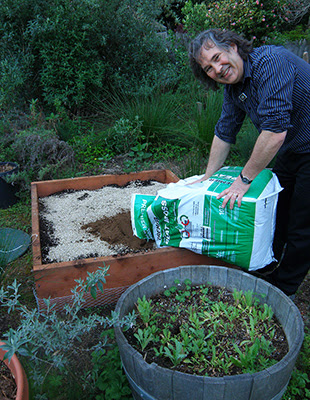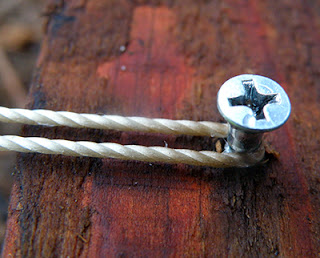 |
| Bruce in Action |
Instructions by Bruce
Once you have a raised
bed built for your square foot garden (details in Sunday’s
post,) you’re ready to fill it with soil, make the square foot grid
sections, and plant your seeds. You can also build a hoop
house to protect small plants from cold temperatures; I will give hoop house
instructions in my next post. All
New Square Foot Gardening, the latest and greatest book by SFG pioneer Mel Bartholomew, recommends soil made
from equal parts of peat moss, vermiculite, and organic compost from several
sources. Vermiculite holds moisture and reduces the amount of watering
necessary. But there is considerable debate
about it due to its high cost and sustainability (it’s mined). Bruce reduced
the amount of vermiculite in the mix. He noted that a high quality compost
mixture also holds substantial water as well as loosening the
soil—vermiculite’s other soil-building contribution. Bruce replaced the classic
SFG wooden
grid with a woven grid of nylon twine secured by wood screws, both of which
we had on hand. Without a grid, as Mel Bartholomew points out, it’s not a
square foot garden.
 |
| Making the SFG Soil |
 |
| Keeping Track of What's Planted Where |
Square Foot Garden: Soil, Grid, and Plants
Materials & Tools:
7.5 cubic feet quality organic compost
6 cubic feet peat moss
22 quarts (2 small bags) vermiculite
Landscaping
rake or small shovel
Yardstick or tape measure
Pencil or scribe
Screwdriver bit for drill
12 – ½-inch #6 wood screws
~40 feet nylon twine
With yardstick or measuring tape and pencil or scribe, mark
off 1-foot increments on the top edge of one side of the raised bed. Starting
one foot from corners, use drill to screw wood screws into the center of each
mark. Don’t tighten screws down flush, leave a small space to tie the twine
around. Mark other sides of the raised bed and add screws.
Adding optional Hoop House Hardware:
Now is the most convenient time to add the hoop house
hardware, before making the grid. Alternatively, you could add it after making
the grid and even after planting. Hoop house instructions in Friday’s post.
Making the Soil:
Instead of the standard SFG practice of mixing the soil on a
tarp (and getting the tarp all gritty), Bruce mixed it up directly in the
raised bed. He added compost first, followed by vermiculite, and peat moss on
the top. Then he used the flat side of the rake to mix it together. You might
prefer a shovel. Using the tine side of the rake runs the risk of snagging and
breaking the gopher wire. Mix soil components together well, then level out.
Start stringing nylon twine on shorter sides of bed. This
means you’ll be making the longer dimension of the (twine) grid first. It’s
easiest and strongest to double the twine: tie twine to one screw, stretch
twine tightly across bed around screw on opposite side, then bring twine back
to original screw, pull tight and tie securely. Cut twine and proceed to
adjacent screw, completing the short sides of the bed first.
 |
| The Basics of Weaving |
 |
| "Trapping" Warp with Weft |
Planting the SFG:
Water the bed well and let it drain. Make sure it’s moist.
Meanwhile, make a diagram of your bed and its grid and label each section with
what you will plant. You might want to start with short plants in front:
lettuces and other greens, and tall climbing plants like beans in the back row
where you can prop up stakes during the season.
Check the seed packages for recommended plant spacing and
planting depth. Follow these instructions for each seed. Note that if
recommended spacing is 12 inches, you’ll only one plant will occupy that
section; if it’s 6 inches, two plants will go in the section, etc. Make a note
of the germination time for each seed variety from its package. Lastly, make a
note of the date you planted the garden.
Classic planting technique calls for 2 seeds to be planted
in each hole, in case one seed doesn’t sprout. This means you’ll have to pinch
off the weaker plant as the plants start to grow. It’s hard for some people
(including yours truly) to kill off a seedling like this, so if you prefer,
plant one seed to each hole. You can always replant a section if no seedlings
come up. In fact, double planting is not a guarantee that all sections will
germinate (especially if temperatures get low), and replanting one or more
sections isn’t unusual. Replant a section if the plants don’t come up during
the germination time listed on their package.
Water the beds again after planting. More tips on watering
and temperature control, including hoop house construction, in Friday’s post!


My little raised bed garden is 4' x 4'. I never thought to mark off the grid. Great idea! I'll definitely be doing that this year -- and good reminder to mark it all down in a notebook, too. You're right, the markers go missing very quickly.
ReplyDeleteVisiting this blog is our real pleasure.Should like to thanks for sharing such a useful information.
ReplyDelete